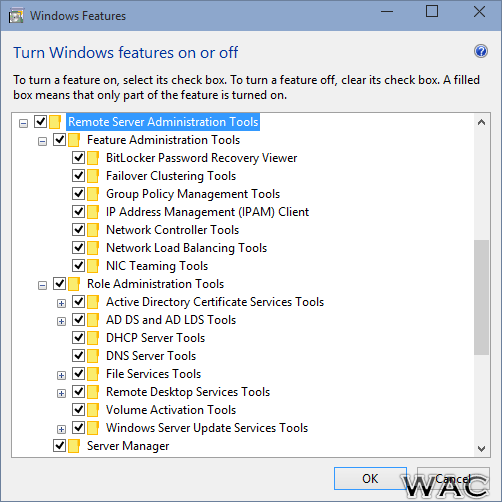Remote Administrator Tools Windows 7
Windows Firewall with Advanced Security is included within Administrative Tools in Windows 10, Windows 8, Windows 7, and Windows Vista. The firewall built-in to Windows is enabled by default, but you can always disable it and use a third-party program. Dec 22, 2017 ' Remote Server Administration Tools for Windows® 7 with SP1 enables IT administrators to manage roles and features that are installed on computers that are running Windows Server® 2008 R2, Windows Server® 2008, or Windows Server® 2003, from a remote computer that is running Windows 7 or Windows 7 with SP1. ' Download the toolkit here. This article describes the tools that are available for installation as part of Remote Server Administration Tools for Windows 7. Tools in this package can be used to manage technologies that run on Windows Server 2008 R2 and also some technologies that run on Windows Server 2003, Windows Server 2003 R2, or Windows Server 2008.
So right now, there are mixed with XP and Windows 7. I installed Remote Admin tools for Windows 7. All seems to be fine but when I opened users account/properties, I don't see a few things usually availble in XP remote admin tools, such as the property tabs for Terminal Service Profile. I need it to set up user access for Citrix. Display Administrative Tools on the Windows 7 Start Menu. Add the Administrative Tools menu to either the Start menu or to the Start menu and the All Programs submenu of the Start menu by completing the following steps: Right-click Start, and then click Properties.
Remote Server Administration Tools (RSAT) for Windows 10 is a collection of programs for IT pro. It helps to manage Servers from a Windows 10 computer. Starting with Windows 10 v1809 aka October 2018 update, one needs to Install Remote Server Administration Tools for Windows 10 as Optional Features or as Features on Demand.
The program includes Server Manager, Microsoft Management Console (MMC) snap-ins, consoles, Windows PowerShell cmdlets and providers, and command-line tools for managing roles and features that run on Windows Server.
Install Remote Server Administration Tools on Windows 10
If you are running Windows 10 v1809 or later, RSAT tool needs to be installed as a set of “Features on Demand” right from Windows 10. You can install RSAT tools on Windows 10 Professional or Windows 10 Enterprise. That said, make sure that you do not install RSAT directly from Microsoft Download page.

- Open Settings, and navigate to Apps > Apps & Features
- Click on Manage Optional Features > Add a Feature. This will load all the optional features one can install.
- Scroll to find the listing of all RSAT tools.
- As of now, there are like 18 RSAT tools. Depending on what you need, click and install it.
Go back, and you should be able to see the installation progress. Click on Manage Optional Features Page to see the status. If you are comfortable with command line, or automation, you can install Remote Server Administration Tools for Windows 10 using DISM /add-capability. Read more about this on Microsoft.
Note: When you install anything using “Features on Demand”, they stay across Windows 10 version upgrades.
How to uninstall specific RSAT tools on Windows 10 v1809
If you feel you don’t need an RSAT feature, you can uninstall from Manage Option Features. However, do remember that some tools depend on another. So if you uninstall anything, and if it has a dependency, it will fail.
Free online piano books for beginners. Free Beginner Piano Lessons The first 5 Lessons of the Progressive Beginner Piano book are available for FREE online here. Click the links in the table of contents below to get started. Using This eBook. Using The Enhanced Features. Approach to Practice. How to Sit At The Piano.
- Navigate to Settings > Apps > Manage Optional Features.
- Find the list of installed feature that appears post this.
- Next, select the feature you want to uninstall and go back.
Note: You can also uninstall it using command line tools or automation using DISM /remove-capability.
To install Remote Server Administration Tools for Windows 10 (before v1809)
If you haven’t installed October update yet, you can install the RSAT tool by directly downloading from Microsoft. Make sure to select the right language and Windows versions. It is available in the following languages: cs-CZ, de-DE, en-US, es-ES, fr-FR, hu-HU, it-IT, ja-JP, ko-KR, nl-NL, pl-PL, pt-BR, pt-PT, ru-RU, sv-SE, tr-TR, zh-CN, and zh-TW. This means you will need to install relevant language pack if its different from what you want to use.
Once installed, you can use the same Manage Optional Features section. Add or remove part of the tools which is not needed anymore.
Related Posts:
Remote Server Administration Tools for Windows® 7 with SP1 enables IT administrators to manage roles and features that are installed on computers that are running Windows Server® 2008 R2, Windows Server® 2008, or Windows Server® 2003, from a remote computer that is running Windows 7 or Windows 7 with SP1.

This tool includes support for remote management of computers that are running either the Server Core or full installation options of Windows Server 2008 R2 with SP1, Windows Server 2008 R2, and for some roles and features, Windows Server 2008.
Remote Administrative Tools Windows 7
Some roles and features on Windows Server 2003 can be managed remotely by using Remote Server Administration Tools for Windows 7 with SP1, although the Server Core installation option is not available with the Windows Server 2003 operating system.This feature is comparable in functionality to the Windows Server 2003 Administrative Tools Pack and Remote Server Administration Tools for Windows Vista with Service Pack 1 (SP1).
Remote Server Administration Tools Windows 7 Not Available
Remote Server Administration Tools for Windows 7 with SP1 can be installed ONLY on computers that are running the Enterprise, Professional, or Ultimate editions of Windows 7 or Windows 7 with SP1.